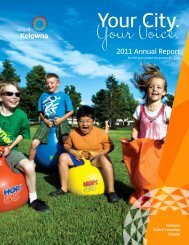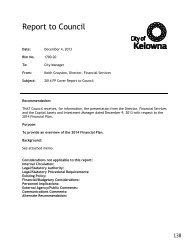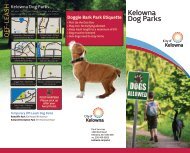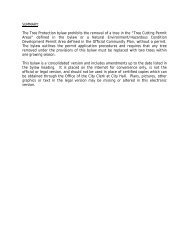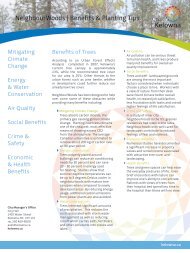Comprehensive Site Development Plan ... - City of Kelowna
Comprehensive Site Development Plan ... - City of Kelowna
Comprehensive Site Development Plan ... - City of Kelowna
Create successful ePaper yourself
Turn your PDF publications into a flip-book with our unique Google optimized e-Paper software.
Avocets at Glenmore Landfill<br />
8<br />
islands would depend on the water level at any given time but should generally be 3 m wide, to<br />
reduce the amount <strong>of</strong> area exposed out <strong>of</strong> the water, and maximize the foraging area in shallow<br />
water. A shallow 35 m periphery zone would surround the island ridges and would have<br />
incorporated into it a deep-water moat <strong>of</strong> ~ 1.5 m depth and 5-10 m width. Overall depth <strong>of</strong><br />
water would be 5-17 cm.<br />
This design is not the only possible design, however. Clusters <strong>of</strong> shorter islands could work just<br />
as well as the proposed island ridges, or ridges that are not as continuous could work as well.<br />
However, the Tulare Lake Drainage District (1996) found that long island ridges did work very<br />
successfully as avocet nesting habitat. This design would also depend on relatively fine control<br />
<strong>of</strong> water levels. Other designs would be necessary if fine control <strong>of</strong> water levels is not possible<br />
while maintaining high alkalinity.<br />
4. Literature Cited<br />
Ambrozy, Samantha. 1999. Water chemistry preferences for habitat <strong>of</strong> American Avocet in<br />
British Columbia. Report prepared under auspices <strong>of</strong> Deep River Science Academy,<br />
Okanagan University College for Central Okanagan Naturalists Club, <strong>Kelowna</strong>, British<br />
Columbia.<br />
Campbell, R.W. 1972. The American Avocet (Recurvirostra americana) in British Columbia.<br />
Syesis 5:173-178.<br />
Campbell, R.W., N.K. Dawe, I. McTaggart-Cowan, J.M. Cooper, G.W. Kaiser and M.C.E.<br />
McNall. 1990. The birds <strong>of</strong> British Columbia. Volume 2. Royal British Columbia<br />
Museum, Victoria, BC and Canadian Wildlife Service, Delta, BC.<br />
Cannings, R.A., R.J. Cannings and S.G. Cannings. 1987. Birds <strong>of</strong> the Okanagan valley, British<br />
Columbia. Royal BC Museum, Victoria, BC.<br />
Cooper, J.M. 1983. Recent occurrences <strong>of</strong> the American Avocet in British Columbia. Murrelet<br />
64: 47-48.<br />
Fraser, D.F., W.L. Harper, S.G. Cannings and J.M. Cooper. 1999. Rare birds <strong>of</strong> British Columbia.<br />
Wildlife Branch and Resource Inventory Branch, Ministry <strong>of</strong> Environment, Lands and<br />
Parks, Victoria. 244 pp.<br />
Gebauer, M. 2000. Status <strong>of</strong> the American Avocet in British Columbia. Wildlife Branch, B.C.<br />
Ministry <strong>of</strong> Environment, Lands and Parks, Victoria, B.C.<br />
Girard, O. and P. Yesou. 1991. Developpement spatial d’une colonie d’avocettes (Recurvirostra<br />
americana). Gibier Faune Sauvage Vol. 8 Mars 1991: 31-42.<br />
Giroux, J.F. 1985. Nest sites and superclutches <strong>of</strong> American avocets on artificial islands.<br />
Canadian J. Zool. 63:1302-1305.<br />
Kondla, N. G., and H. W. Pinel. 1978. Clutch size <strong>of</strong> the American Avocet in the prairie<br />
provinces. Blue Jay 36: 150-153.<br />
MacNeil, Christina. 1999. Abundance and types <strong>of</strong> potential invertebrate prey <strong>of</strong> American<br />
Avocet in British Columbia. Report prepared under auspices <strong>of</strong> Deep River Science<br />
Academy, Okanagan University College for Central Okanagan Naturalists Club, <strong>Kelowna</strong>,<br />
British Columbia.<br />
Manning, Cooper and Associates



